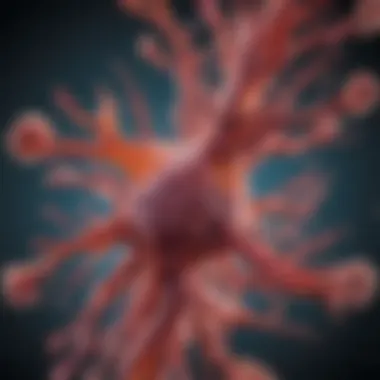Understanding LC3A Antibody: Structure and Applications


Intro
The understanding of the LC3A antibody is becoming increasingly vital in the field of cellular biology and medical research. LC3A plays a significant role in autophagy, which is the process by which cells degrade and recycle components. Investigating the structure and function of the LC3A antibody helps clarify its importance in various pathways and diseases. This article aims to provide a comprehensive overview, detailing methodologies, discussing implications in clinical research, and highlighting potential areas for further exploration.
Methodologies
The study of LC3A antibody involves various research techniques and tools that facilitate its understanding in cellular processes and disease states. Employing diverse methodologies allows researchers to map the role of LC3A in autophagy and its implications in health and disease.
Description of Research Techniques
Research techniques specific to the LC3A antibody include:
- Immunohistochemistry (IHC): This technique visualizes protein expression in tissue sections, helping to determine the localization of LC3A in various cell types.
- Western Blotting: A common method for detecting specific proteins in a sample, this technique allows for quantification and assessment of LC3A levels in biological samples.
- Fluorescence Microscopy: This enables the observation of LC3A in live cells, providing insights into its dynamic behavior in real-time cellular environments.
- ELISA (Enzyme-Linked Immunosorbent Assay): A technique that quantifies the concentration of LC3A in samples, allowing for a detailed analysis of its expression in different conditions.
Tools and Technologies Used
An array of tools and technologies are employed to study the LC3A antibody effectively. Some notable examples include:
- Flow Cytometry: For analyzing the physical and chemical characteristics of cells, allowing researchers to assess LC3A expression levels quantitatively.
- Mass Spectrometry: Used for protein identification and characterization, it provides detail on post-translational modifications of LC3A that might affect its function.
- Gene Editing Tools (like CRISPR-Cas9): These allow for the manipulation of cells to either knock out or overexpress LC3A, providing insights into its role in disease mechanisms.
Discussion
Comparison with Previous Research
Previous studies have established a foundational understanding of LC3A's role in autophagy. Recent findings build upon these insights and reveal the nuanced roles LC3A may play in various diseases, such as cancer and neurodegenerative disorders. The advancement in technologies has allowed for more precise studies, contrasting earlier research that relied on less refined methodologies.
Theoretical Implications
The implications of LC3A research extend beyond understanding autophagy. By comprehending how LC3A interacts with other cellular components, researchers can formulate hypotheses regarding its impact on cell survival and death. Investigating LC3A's role may lead to targeted therapies that enhance or inhibit its function in diseases, offering potential new avenues for treatment.
Understanding the nuances of LC3A's function can illuminate broader cellular processes and disease mechanisms, opening doors to innovative therapeutic approaches.
Prologue to LC3A Antibody
The LC3A antibody plays a crucial role in the study of cellular processes, particularly autophagy. As researchers delve deeper into the complexities of cellular biology, understanding the functions and applications of the LC3A antibody becomes essential. This section provides insights into its definition and background, as well as its importance within the realm of cellular research.
Definition and Background
LC3A, or microtubule-associated protein 1A/1B light chain 3A, is a protein that is integral to autophagy, which is the cellular mechanism for degrading and recycling cellular components. The LC3A antibody is developed to specifically recognize and bind to the LC3A protein, allowing researchers to investigate its presence and role within various cellular contexts.
The LC3A protein is highly conserved across different species, which indicates its fundamental role in cellular processes. Studies have identified the necessity of LC3A in autophagosome formation, an essential step in autophagy. This characteristic makes it an important subject of study for researchers aiming to understand not just autophagy but also other cellular activities.
Importance in Cellular Research
The significance of the LC3A antibody in cellular research cannot be overstated. First, it serves as a vital tool for the detection and quantification of LC3A during experiments that focus on autophagy. By employing this antibody, researchers can ascertain the levels of LC3A in various cell types under different conditions. This information is critical for evaluating cellular responses to stressors like starvation or hypoxia.
Furthermore, understanding LC3A's role extends beyond mere autophagy research. It has implications in areas like cancer research, neurodegenerative diseases, and infectious diseases. By identifying changes in LC3A expression or localization, scientists gain valuable insights into the underlying mechanisms of these diseases. This connection between basic research and clinical applications underscores the relevance of the LC3A antibody in contemporary scientific studies.
Biological Function of LC3A
The biological function of LC3A is a critical aspect of understanding this antibody and its applications in research. This section will delve into the various roles that LC3A plays within the cellular environment, providing insight into its essential contributions, especially regarding autophagy.
Role in Autophagy


LC3A is vital for the autophagy process, a cellular mechanism that degrades and recycles cellular components. This process is crucial for cellular homeostasis, particularly under stress conditions. During autophagy, LC3A is conjugated to phosphatidylethanolamine, forming LC3-II, which is instrumental for the autophagosome's membrane expansion and maturation. The conversion of LC3A to LC3-II serves as a hallmark of autophagy activation, making it a valuable biomarker for studies related to cellular degradation pathways.
- Function as a Marker: The presence of LC3-II is often used to quantify autophagic activity in experimental settings. An increase in LC3-II levels typically indicates enhanced autophagic flux.
- Cellular Signaling: LC3A also participates in signaling pathways that regulate autophagy. These pathways control the initiation, progression, and termination of autophagic events. Understanding these signaling mechanisms enhances the ability to manipulate autophagy, which is critical for therapeutic interventions.
Interaction with Other Proteins
LC3A does not operate in isolation. It interacts with numerous proteins that are fundamental to the autophagy process. One significant aspect of LC3A's function is its role in the recruitment of autophagic cargo via its interaction with adaptor proteins.
- Cargo Recognition: Adaptor proteins like p62 and NBR1 bind to ubiquitinated substrates and LC3A, facilitating the inclusion of these substrates into the autophagosome.
- Regulated Interactions: These protein interactions are tightly regulated. The ability of LC3A to interact with different proteins allows the cell to adapt to varying stress levels and environmental conditions. This adaptability underscores the multifunctional nature of LC3A in autophagic regulation.
Regulatory Mechanisms
The regulatory mechanisms governing LC3A activity are complex and involve several pathways. Understanding these mechanisms is crucial for researchers aiming to manipulate autophagy for therapeutic purposes.
- Post-Translational Modifications: LC3A undergoes various post-translational modifications that affect its activity and stability within the cell. For example, phosphorylation and ubiquitination can alter LC3A’s functions and interactions.
- Influence of Cellular Cues: Nutritional status and overall cellular energy levels significantly influence LC3A's role in autophagy. For instance, during nutrient starvation, a signaling cascade involving ULK1 activates LC3A, promoting the formation of autophagosomes.
The comprehensive understanding of LC3A and its interactions is essential for elucidating autophagy's role in health and disease, thereby paving the way for potential therapeutic approaches.
Production of LC3A Antibody
The production of LC3A antibody is a critical component in the study of cellular mechanisms, particularly autophagy. Understanding how this antibody is generated helps researchers ensure its efficacy in various applications. Moreover, the quality of the antibody directly affects experimental outcomes. This section will explore the sources from which LC3A antibodies are derived and the techniques used for their purification, both of which are essential for obtaining reliable research results.
Sources of Antibody
LC3A antibodies are typically produced using two primary sources: polyclonal and monoclonal systems.
- Polyclonal antibodies: These antibodies are generated from multiple B-cell clones, each producing antibodies against different epitopes of the LC3A protein. This diversity can enhance sensitivity. However, it may result in variability between batches due to the mixture of antibodies that target different regions of the antigen.
- Monoclonal antibodies: In contrast, these are derived from a single clone of B cells. Monoclonal antibodies provide higher specificity because they recognize only one epitope. This precision can be particularly advantageous in applications requiring a clear signal amidst background noise.
Choosing the right source is essential, as it influences factors such as specificity, sensitivity, and reproducibility in experiments. Researchers should weigh the advantages and disadvantages of each method based on their particular needs.
Purification Techniques
Once the antibodies are generated, purification techniques are applied to isolate them from other serum proteins and contaminants. The most common methods include:
- Affinity Chromatography: This technique utilizes a specific ligand that binds to the desired antibody, allowing for its selective elution. This process typically results in a high-purity antibody preparation, suitable for most applications.
- Ion Exchange Chromatography: By exploiting the charge properties of proteins, this technique separates antibodies based on their net charge. Variations in pH and ionic strength can be used to elute the antibodies at different stages, leading to a refined product.
Purification methods can greatly influence the functionality and reactivity of the antibodies. As such, it is crucial for researchers to choose an appropriate purification technique that aligns with their experimentation requirements. In summary, the production of LC3A antibodies encompasses careful consideration of sources and purification methods to achieve optimal quality for research applications.
Detection Techniques for LC3A
Detection techniques for LC3A are essential for elucidating its roles in various biological processes, particularly in the study of autophagy. With an understanding of these techniques, researchers can accurately assess the presence and activity of LC3A in different cellular contexts. Various methodologies provide specific advantages, allowing for the identification and quantification of LC3A in tissues and cell cultures. This section will delve into three primary techniques: Western blot analysis, immunofluorescence, and flow cytometry applications. Each approach has its unique characteristics that researchers must consider depending on their specific research objectives.
Western Blot Analysis
Western blotting is a powerful technique widely used for detecting specific proteins in complex samples. In the context of LC3A, it enables researchers to evaluate changes in expression and processing under various cellular conditions. The procedure begins with the separation of cellular proteins by size through gel electrophoresis. Once separated, the proteins are transferred onto a membrane, where they are probed with specific antibodies against LC3A.
The advantages of Western blotting include:
- Quantitative analysis: This technique can provide relative quantification of LC3A levels under different experimental conditions.
- Detection of processed forms: Western blot analysis can distinguish between the lipidated (LC3-II) and unlipidated (LC3-I) forms of LC3A, which are critical in autophagy studies.
However, it is important to note potential limitations as well. Signal intensity can vary greatly due to factors like the quality of antibody, sample preparation, and detection methods. Moreover, the technique requires relatively large sample volumes and can be time-consuming.
Immunofluorescence Techniques
Immunofluorescence is another widely adopted method for visualizing LC3A within cellular contexts. This technique employs fluorescently labeled antibodies that bind specifically to LC3A, allowing researchers to visualize its distribution in fixed cells or tissue samples. The advantage of using immunofluorescence is its ability to provide spatial information on LC3A's localization within cells. This is crucial for understanding how LC3A participates in cellular structures such as autophagosomes.


Key components of immunofluorescence techniques include:
- Visualization of localization: The use of fluorescent tags enables the observation of LC3A in specific cellular compartments, providing insights into autophagy pathways.
- Co-localization studies: Researchers can also combine multiple antibodies to study interactions between LC3A and other proteins, adding depth to cellular functional analysis.
However, the potential drawbacks include:
- Need for optimization: The protocols may require fine-tuning of fixation and permeabilization methods for effective results.
- Signal fading: Fluorescent signals can diminish over time, potentially complicating analyses if samples are not processed promptly.
Flow Cytometry Applications
Flow cytometry is a sophisticated technique that provides a rapid and quantitative analysis of cell populations. In the study of LC3A, flow cytometry allows for the measurement of LC3A expression at the single-cell level, which is a significant advantage for understanding heterogeneous cell populations. This technique can be combined with other markers to investigate the status of autophagy across different cell types simultaneously.
The benefits of flow cytometry include:
- High-throughput analysis: Researchers can analyze thousands of cells per second, making it efficient for large sample sizes.
- Single-cell resolution: The technique permits examination of variations in LC3A expression within different cells, enhancing the depth of cellular analysis.
Still, it is crucial to recognize some limitations related to flow cytometry. The complexity of sample preparation and the requirement for cells to be in suspension may restrict analyses of certain tissues or conditions. Additionally, appropriate controls and compensation for spectral overlap must be established for accurate results.
In summary, each detection technique for LC3A has its unique strengths and challenges. Choosing the right method depends on the specific research question, the nature of the biological sample, and the desired outcome.
Clinical Implications of LC3A Antibody
The LC3A antibody holds significant importance in clinical research, notably in understanding various diseases. It plays a vital role in exploring the mechanisms underlying cellular processes, particularly autophagy. This section discusses the implications of LC3A in cancer research, neurodegenerative diseases, and infectious disease studies. Each of these areas not only highlights the necessity of LC3A in advancing scientific understanding but also underscores its potential applications in therapeutic developments.
Role in Cancer Research
Cancer research has made substantial strides with the application of the LC3A antibody. Autophagy, the process by which cells degrade and recycle components, has a complex relationship with tumor biology. In certain cancers, such as breast and colon cancer, LC3A acts as a marker for autophagic activity. Increased levels of LC3A can indicate heightened autophagic responses in tumor cells.
Research shows that inhibiting autophagy in specific cancer types can enhance the effectiveness of chemotherapy. The LC3A antibody aids researchers in tracking these processes. By analyzing LC3A expression levels in tumor biopsies, scientists gain insights into cancer progression and treatment responses.
"Understanding the role of LC3A in cancer can reveal potential therapeutic targets and inform treatment strategies."
Impacts on Neurodegenerative Diseases
The implications of LC3A extend to the study of neurodegenerative diseases like Alzheimer's and Parkinson's. Autophagy is crucial for maintaining neuronal health, as it helps clear damaged proteins and organelles. Studies suggest that impaired autophagy contributes to the buildup of toxic aggregates, a hallmark of these diseases. Thus, the LC3A antibody is essential in examining autophagic dysfunctions in neurodegenerative contexts.
Researchers utilize LC3A to investigate changes in autophagy activity in neurons. An increase or decrease in LC3A levels can provide critical information regarding disease states and progression. Such insights are vital for developing therapeutic strategies aimed at enhancing autophagic processes in the brain.
Potential in Infectious Disease Studies
Infectious diseases also benefit from the exploration of LC3A's role. Pathogens often manipulate host autophagy to promote their survival. The LC3A antibody can help assess the autophagic response triggered by infections. By studying the interaction between LC3A and pathogens, researchers can identify how certain viruses or bacteria evade immune responses.
Understanding these interactions is critical for developing new therapeutic approaches against infectious diseases. Manipulating autophagy pathways might enhance host defenses, presenting a novel avenue for treatment.
In summary, the clinical implications of the LC3A antibody are vast. Its role in cancer research, neurodegenerative diseases, and infectious disease studies highlights its significance in advancing medical knowledge and therapeutic application. As research in these domains progresses, the LC3A antibody will continue to be an essential tool for probing the intricacies of cellular function and disease pathology.
Challenges in LC3A Research
The study of LC3A antibody is significant due to its role in cellular processes like autophagy. However, researchers encounter several obstacles in its application and study. Addressing these challenges is crucial, as they can potentially impact the discovery of therapeutic targets and the understanding of disease mechanisms.
Antigenicity Issues
Antigenicity refers to the ability of a substance to provoke an immune response. In the context of LC3A research, antigenicity issues can arise due to various factors. Firstly, the structure of LC3A might vary between different species or even within the same species under different conditions. This variability can lead to differences in how well the antibody recognizes the antigen, complicating experimental outcomes.
Moreover, post-translational modifications of LC3A can alter its antigenicity. If the antibody does not adequately bind to the modified versions of LC3A, it could yield inaccurate data. This is particularly relevant when studying diseases where these modifications might occur, such as in cancer or neurodegenerative disorders. Thus, researchers must ensure they are using antibodies that are appropriate for the specific context of their study.


Reproducibility Concerns
Reproducibility is a fundamental principle in scientific research that can sometimes be hindered in the study of LC3A antibodies. Various factors contribute to this concern. Different labs may obtain antibodies from various manufacturers, resulting in inconsistencies. Even slight differences in antibody production, such as the purification process or the host animal used, can greatly influence the results.
Furthermore, experimental conditions can vary widely. Factors like cell lines used, assay methods, and even environmental conditions may affect the stability and activity of the LC3A antibody. Such variations can lead to divergent results across studies, making it difficult to verify findings or build upon them.
Efforts are required to standardize protocols and methodologies around LC3A research. This includes clear guidelines on antibody validation and consistent experimental conditions, which are crucial for achieving reproducible results in the study of LC3A antibody applications.
Maintaining rigorous standards in LC3A research will enhance the credibility of findings.
Understanding and mitigating these challenges is essential for advancing research involving LC3A antibodies. As the scientific community continues to explore the implications of LC3A in various diseases, resolving these issues will lead to more reliable results and better therapeutic applications.
Future Directions in LC3A Research
Research on the LC3A antibody is evolving rapidly, with many exciting opportunities on the horizon. This section explores the potential future developments in LC3A studies, highlighting emerging technologies and prospects for therapeutic applications. Understanding these directions is essential for researchers who want to maximize the potential of LC3A in various fields, including cell biology, oncology, and neurobiology.
Emerging Technologies
The landscape of LC3A research is being reshaped significantly by novel technologies. Advances in techniques such as CRISPR gene editing are facilitating the exploration of LC3A's role at an unprecedented level. This technology could enable researchers to create precise gene knockouts, allowing for a better understanding of LC3A's function in cellular processes.
Additionally, mass spectrometry and next-generation sequencing are enhancing the ability to analyze protein interactions in more complex biological systems. High-throughput screening combined with these tools can lay the groundwork for discovering new LC3A-associated pathways. As these techniques advance, they could unveil previously unknown roles that LC3A plays in health and disease.
Another important technology is the integration of artificial intelligence in data analysis. Bioinformatics can assist researchers in handling large datasets, providing deeper insights into the correlations between LC3A levels and various diseases. This will help researchers identify trends and make predictions regarding LC3A's involvement in different biological contexts.
"Emerging technologies will pave the way for a deeper understanding of LC3A's functions and applications."
Potential Therapeutic Applications
The therapeutic potential of the LC3A antibody is particularly noteworthy, especially in the context of diseases such as cancer and neurodegenerative disorders. Researchers are increasingly investigating whether modulating autophagy through the LC3A pathway can open new avenues for treatment. This could involve either enhancing or inhibiting LC3A's function, depending on the specific disease context.
In cancer research, manipulating the autophagy process could lead to novel strategies for overcoming resistance to chemotherapy. By targeting LC3A, scientists may improve the effectiveness of existing chemotherapeutic agents. Furthermore, examining LC3A's role in tumor microenvironments could yield insights into immune evasion and tumor progression.
For neurodegenerative diseases like Alzheimer’s, understanding how LC3A facilitates the clearance of aggregated proteins is critical. Accelerating this process may provide therapeutic opportunities. Research focusing on developing drugs that enhance LC3A-mediated autophagy could be vital to managing or even preventing these conditions.
The intersection of LC3A research with regenerative medicine is also an area of great promise. As scientists uncover more about how LC3A participates in cellular repair mechanisms, targeted therapies may emerge that utilize the antibody to stimulate autophagy during recovery from injury or disease.
In summary, the future directions in LC3A research present numerous opportunities. Emerging technologies promise to unravel the complexities of LC3A function. Moreover, the potential for therapeutic applications in various medical fields marks this area of study as one to watch closely.
Culmination
The conclusion of this article serves as a final reflection on the multifaceted role of LC3A antibody in the realm of scientific research. It encapsulates the main elements of LC3A, including its structure, biological functions, and applications in various fields.
The significance of LC3A antibody is paramount, especially in the context of autophagy studies. This process is vital for cellular homeostasis and plays a crucial role in numerous diseases. The findings discussed throughout this article highlight how the LC3A antibody is not merely a tool but a gateway to uncovering the complexities of cellular processes. Researchers rely on this antibody for its specificity in detecting autophagic activity, which can lead to breakthrough discoveries in understanding diseases.
Moreover, the challenges faced in LC3A research, such as antigenicity issues and reproducibility concerns, remind us of the need for precise methodologies and stringent validation processes. Keeping these considerations in mind will enhance the credibility of LC3A and ensure reliable outcomes in research.
In summary, the LC3A antibody is integral in advancing our comprehension of cellular biology. It has significant implications in cancer research, neurodegenerative diseases, and even infectious disease studies.
Summary of Key Findings
The key findings of this article are as follows:
- Structural Characteristics: The LC3A antibody is essential for understanding the autophagy mechanism at the cellular level. It allows precise identification of LC3A by serving as a marker for autophagic vesicles.
- Functional Roles: LC3A plays a multi-dimensional role in cellular processes. It interacts with other proteins and is involved in regulatory mechanisms guiding autophagy.
- Production and Purification: Methodologies for producing high-quality LC3A antibodies are crucial. Techniques like affinity chromatography ensure the antibody's reliability in research applications.
- Detection Techniques: Various methods, including Western blot, immunofluorescence, and flow cytometry, confirm LC3A's presence in samples. This versatility enhances its applicability across various experiments.
- Clinical Implications: The antibody's relevance extends to cancer, neurodegenerative disorders, and infectious diseases. Researchers are increasingly exploring its potential therapeutic applications.
Final Thoughts on LC3A Antibody
Future research must focus on improving detection methods and overcoming existing challenges related to its use. Ongoing developments in technologies and methodologies hold promise for expanding the roles of LC3A in clinical settings.
Furthermore, as the scientific community continues to embrace the significance of autophagy, the utility of LC3A antibody will undoubtedly thrive. The future of LC3A research appears bright, presenting opportunities for innovations that could lead to novel therapeutic interventions.
Understanding the LC3A antibody is not just beneficial for researchers; it paves the way for insights that could ultimately change patient care in various disease conditions.



